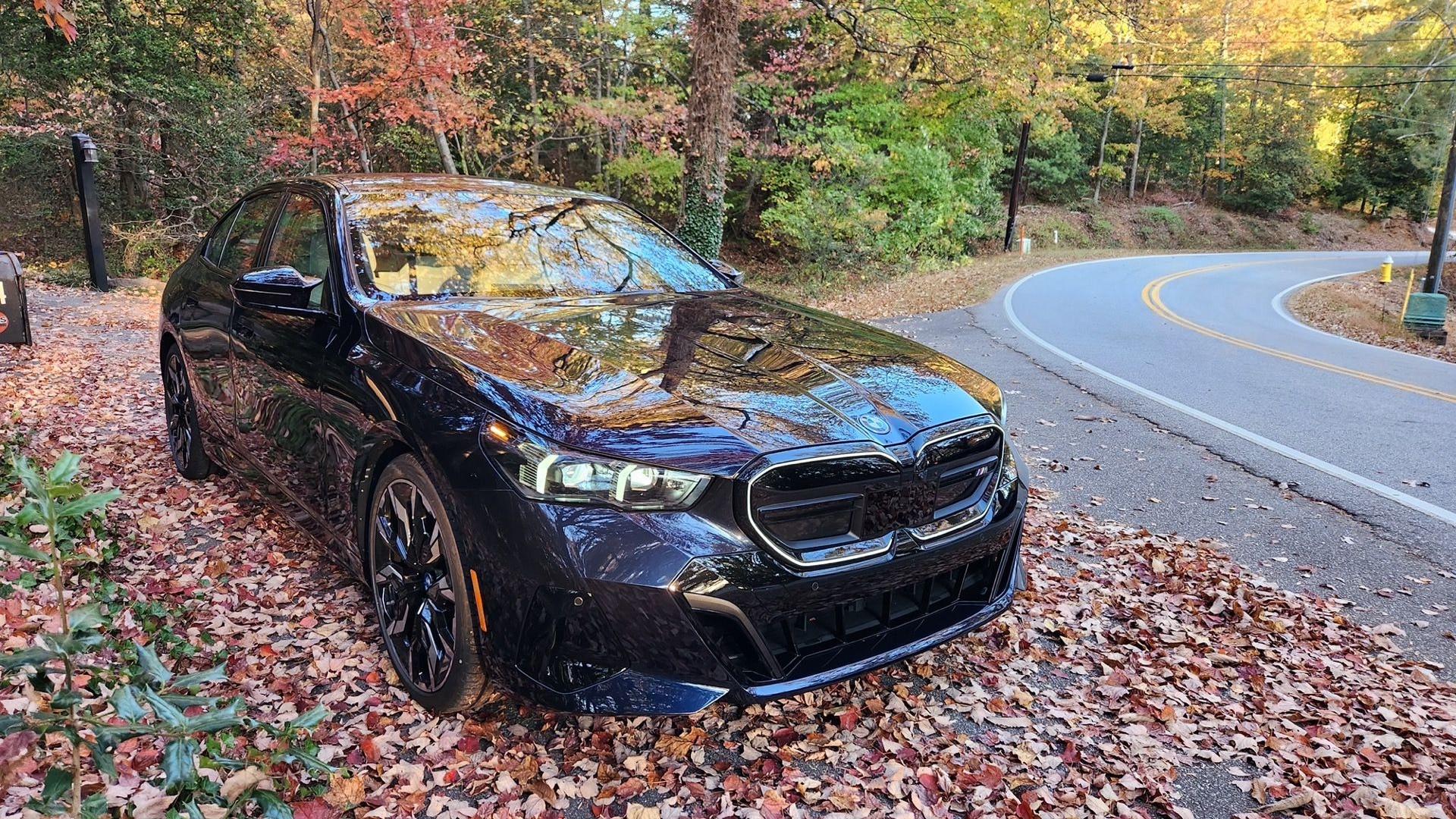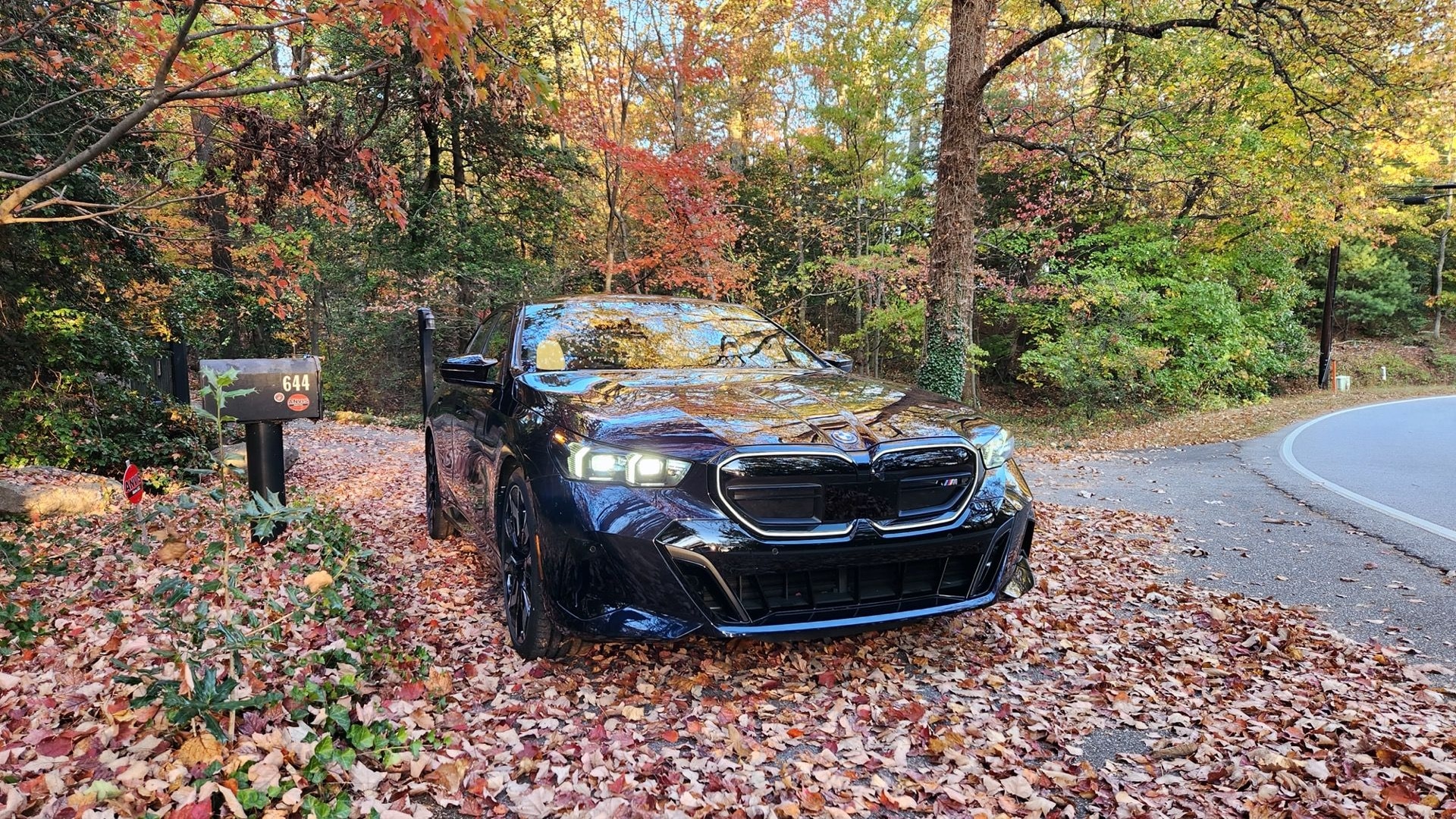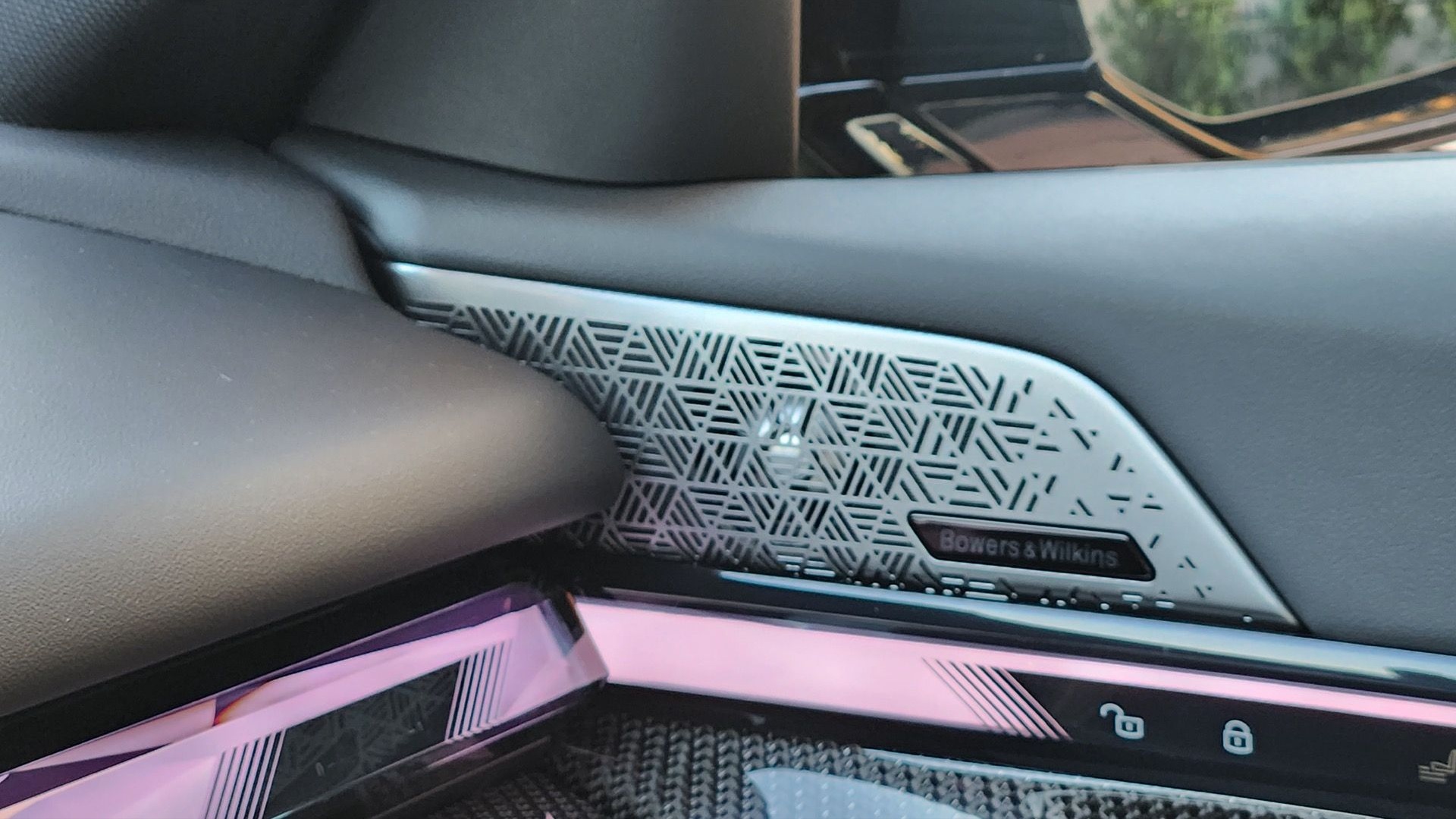The BMW 5-Series has been powered by gasoline and diesel for all its existence on the automotive planet. With the newest version, there's a switch, for the better.
Battery-electric 2024 BMW i5 models will make up roughly half the full range of the eighth-generation midsize sport sedan that first debuted in 1972. As with its larger sibling, the BMW i7, the electric version—though all but identical on the outside—is clearly superior to its gasoline counterparts. Now, the higher-volume 5-Series lineup reinforces that point: In luxury and sports models, EVs are simply better cars.
At a November launch event in and around Greenville, South Carolina, BMW offered up two electric versions and one gasoline model for reporters to drive. They’re the first entries in what will be a range of at least six different 5-Series variants. The pair of i5 models were more pleasant to drive, offered faster acceleration, and a smoother, calmer trip when drivers weren’t using that acceleration. The i5 also costs more ($67,795 to start, including the mandatory $995 delivery fee) versus the comparable gasoline models that will still likely outsell them. The new models are now arriving at BMW dealers, with further versions to come over the next 18 months.
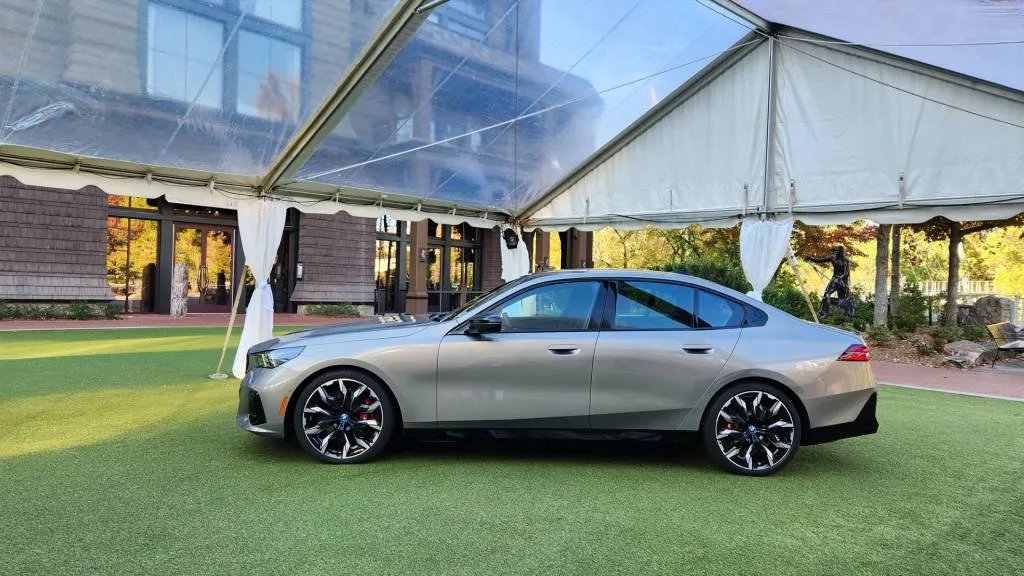
2024 BMW i5
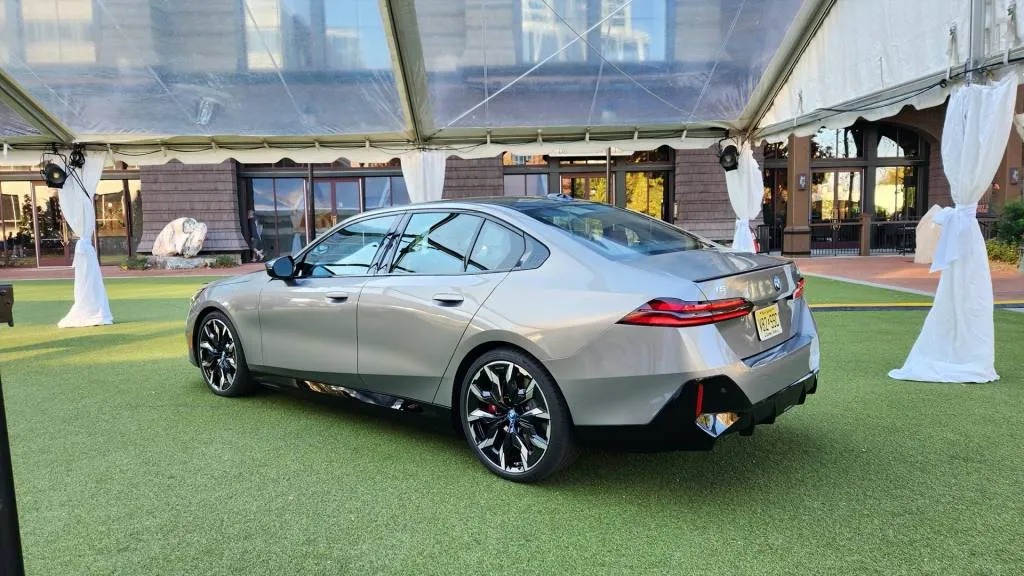
2024 BMW i5
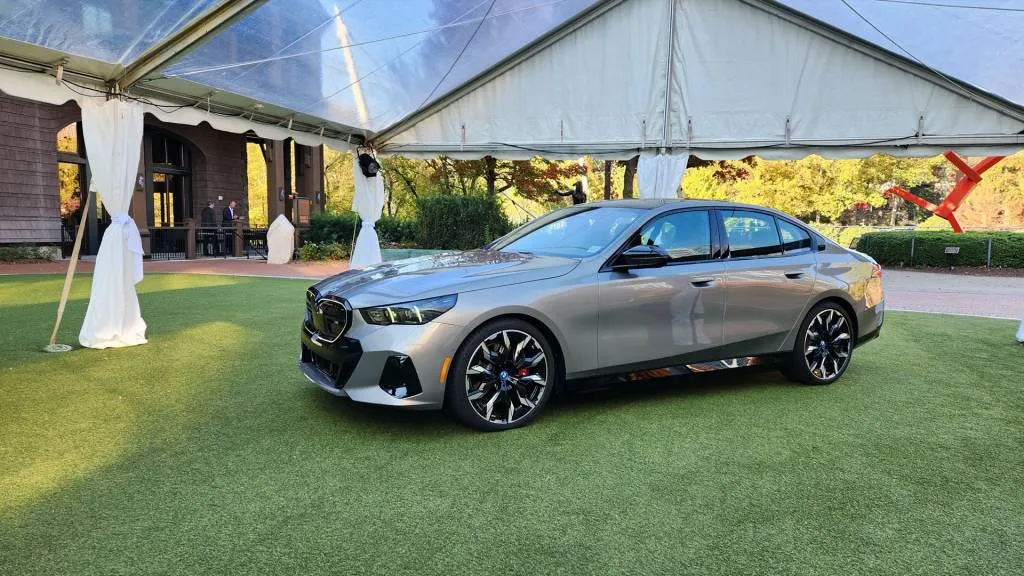
2024 BMW i5
BMW i5 differences vs. 5-Series
Unlike other brands putting their mark on the non-Tesla part of the EV world—Kia comes to mind, as does the Hyundai Ioniq 6 sedan—BMW doesn’t make striking design statements with its electric 5-Series. While BMW's set to again make an edgier statement with its upcoming Neue Klasse EVs, the i5 is one of the least identifiable EVs on the road. It’s even harder to single out than the i7.
The new generation is immediately identifiable as a 5-Series, though with sharper, more sculptured creases to add definition to a smoother, tapering fastback sedan shape. The electric i5 has the same larger twin-kidney grille shape as ICE models, though they’re blanked off with shiny black plates rather than vertical bars. A large fixed panoramic glass roof can be ordered to replace the standard slide-and-tilt glass panel, which lightens the cabin considerably.
Against its predecessor, the 2024 5-Series is slightly enlarged—3.4 inches longer, 1.3 inches wider, and 1.4 inches higher. That lets it retain sedan proportions while accommodating a battery pack under the cabin floor. A black band under the doors hides the height. Wheel options range from 19 to 21 inches, depending on the specific model.
Inside as well, the i5 remains instantly recognizable as a BMW, less so as an EV. A pair of low, horizontal screens sits atop a sweeping dash: the 12.3-inch display behind the steering wheel provides an instrument cluster, while a central 13.9-inch touchscreen duplicates many functions BMW provides through the console-mounted iDrive 8.5 controller.
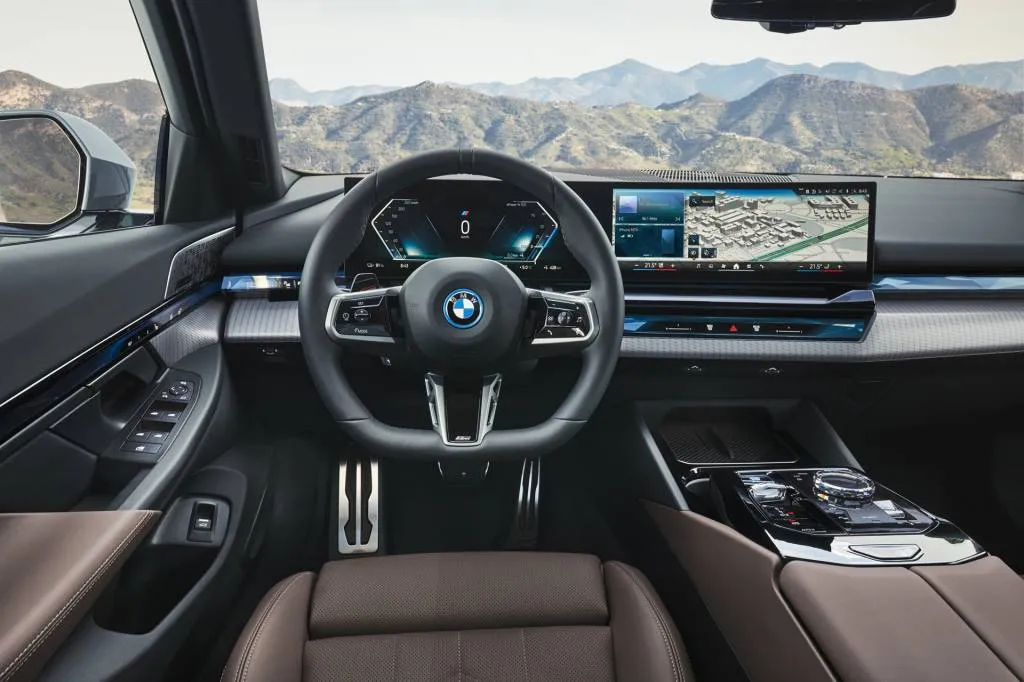
2024 BMW i5
BMW i5 performance shows electric is better
The models we drove in South Carolina are the first two battery-electric 5-Series to go on sale: the 2024 BMW i5 eDrive 40, and the i5 M60 xDrive. As the names imply, the eDrive 40 is rear-wheel drive while the higher-output M60 xDrive powers all four wheels. BMW also teased a future i5 xDrive model, most likely the AWD version of the 40, which would let the low end of the i5 range neatly parallel its gasoline counterparts, the 530i and 530i xDrive.
Both i5 versions we drove use an 82-kwh battery pack under the cabin floor. The eDrive 40’s single rear-mounted motor is rated at 335 hp, while the combined output of the front and rear motors in the M60 is 593 hp. Those ratings are more powerful than comparable gasoline models (255 and 375 hp), as are their quoted 0-to-60-mph acceleration times: 5.7 seconds for the i5 40, versus 5.9 or 5.8 seconds for the rear- and all-wheel-drive versions of the 530i. The hot-rod electric i5 M60 is quoted at a startling 3.7 seconds, but BMW didn’t release acceleration figures for the coming 540i xDrive model with an inline-6.
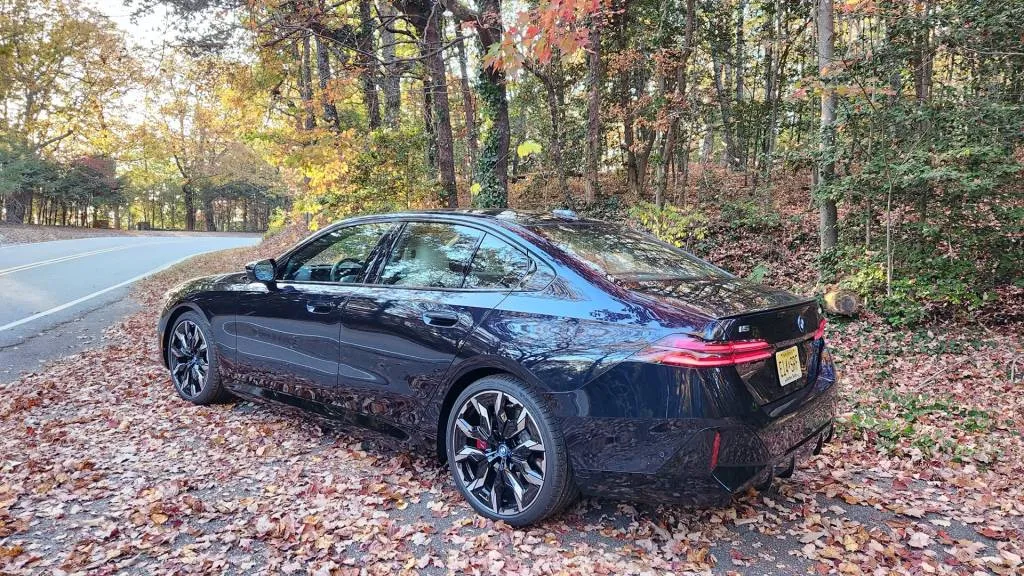
2024 BMW i5
On the road, our rear-wheel-drive i5 eDrive 40 proved plenty capable. With the addition of xDrive all-wheel drive (presumably coming soon), it would be a good all-rounder with longer range than the hot-rod M60. The ride is firm but not harsh, and against the gasoline 530i, the added weight of a low battery made it feel heavier, more solid, and more planted. Our one quibble on the single-motor model was its weak regeneration, even at the maximum setting, and the lack of true one-pedal driving down to a stop. The company has suggested that its drivers prefer more interaction with the controls, but we’re not convinced that applies to the subset that wants an all-electric BMW.
The truly fun version of the electric 5-Series, however, was the i5 M60 xDrive. It offers far stronger regenerative braking plus a 10-second “Boost” function that raises the maximum torque produced by both motors from 549 pound-feet to 605 lb-ft. The result was staggering thrust, accompanied by a synthesized howling noise. Secondly, it includes rear-wheel steering, which made it feel smaller than it is around tight corners—although parking a big sedan remained much the same challenge as ever. Together, those two factors made the M60 our choice for evil-grin driving when required.

2024 BMW i5
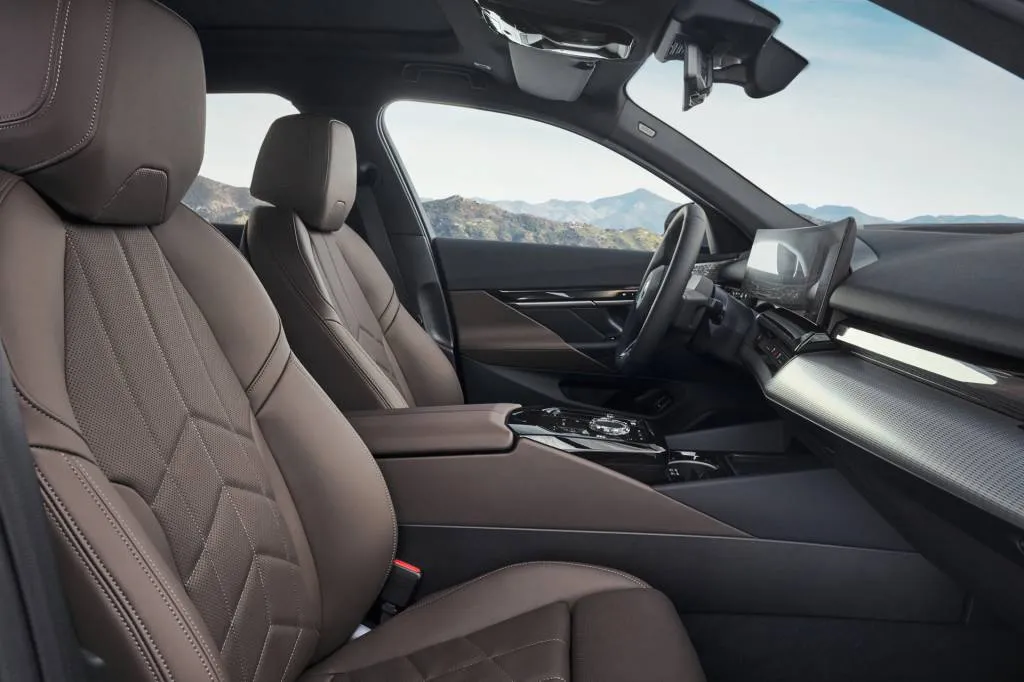
2024 BMW i5
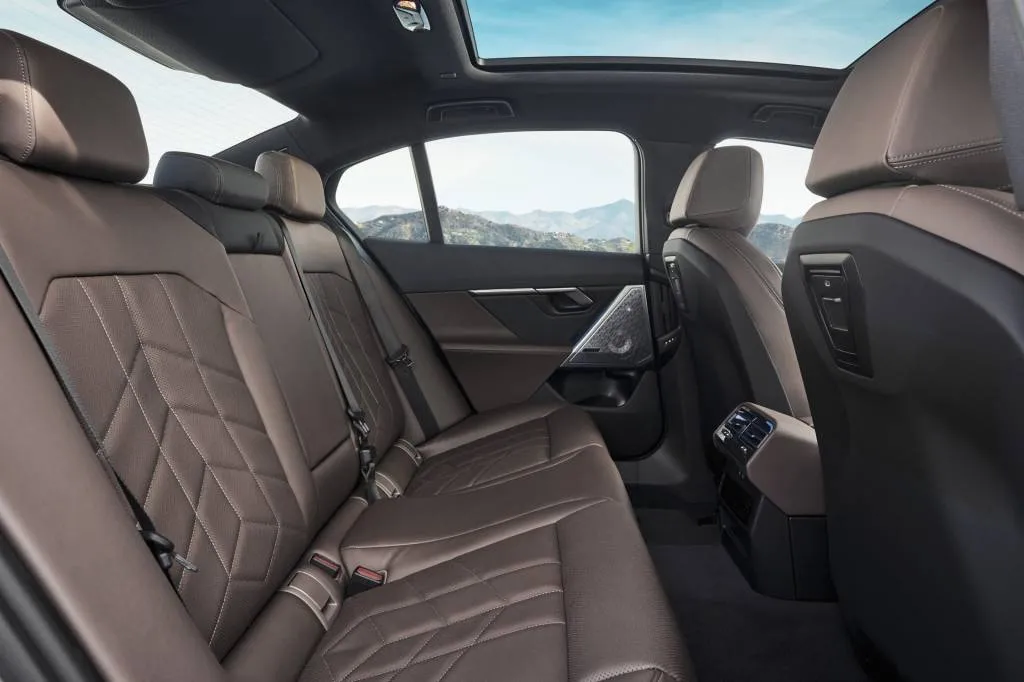
2024 BMW i5
Space for four adults in i5, lots of room to work with
The cabin of the i5 will accommodate four adults in comfort, with a slightly longer wheelbase that increases rear legroom. Front seats are particularly comfortable, and they combine with the ease of EV driving to make the i5 a comfortable cruiser between charging stops.
Trunk space in the i5 is 17.3 cubic feet, about 1 cubic foot less than those of gasoline models. The 40:20:40 split rear seat offers a convenient way to carry larger items, from skis through the center to luggage and boxes with some or all of the seatbacks folded.
Materials won’t surprise anyone who’s been in a BMW lately—yes, it carries on with the expected formality, but a few color options beyond basic German black are available. The array of exterior and interior colors, trim levels, option packages, and standalone features across the BMW i5 would be its own article. Suffice it to say the more powerful of the two comes with the M Sport and M Sport Pro appearance and performance package that includes blackout trim and various other decorative upgrades.
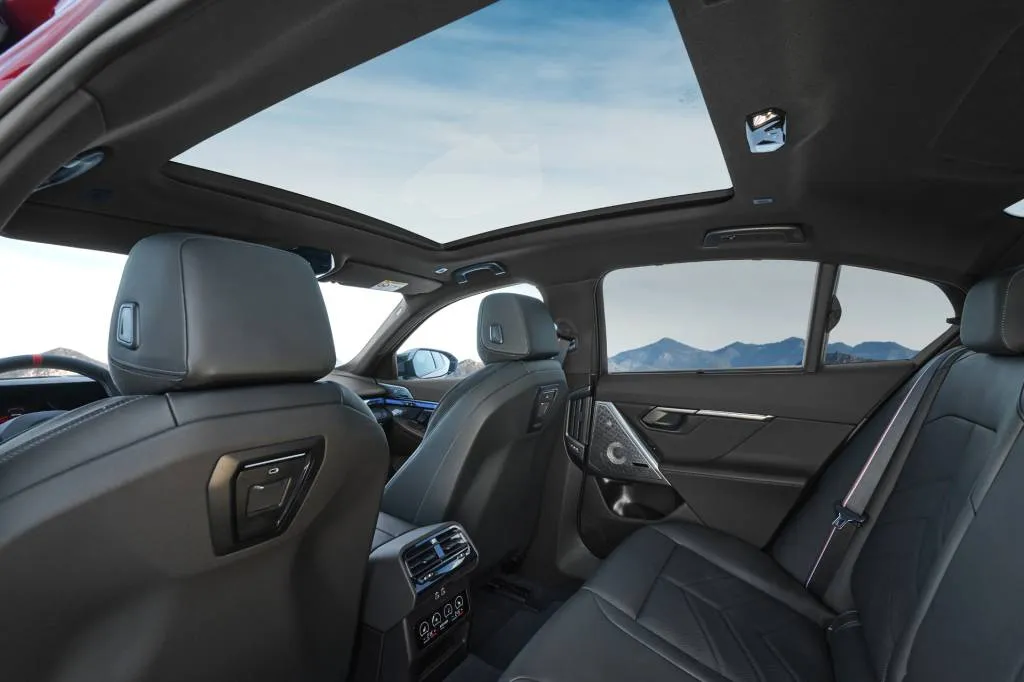
2024 BMW i5
2024 BMW i5 EV safety
Previous generations of the BMW 5-Series have earned high ratings in safety testing, but as yet, neither the NHTSA nor the IIHS has crash-tested the 2024 i5.
All 5-Series come with a lengthy list of standard and optional automated driver-assist systems, with hands-off driving under highway conditions newly added to the optional Driving Assistance Professional system. We weren’t able to test the feature in the limited highway mileage on our drive routes, but we look forward to assessing it against Drive Pilot (from Mercedes Benz), Super Cruise (from GM), Blue Cruise (from Ford), and other similar hands-free adaptive cruise control systems.
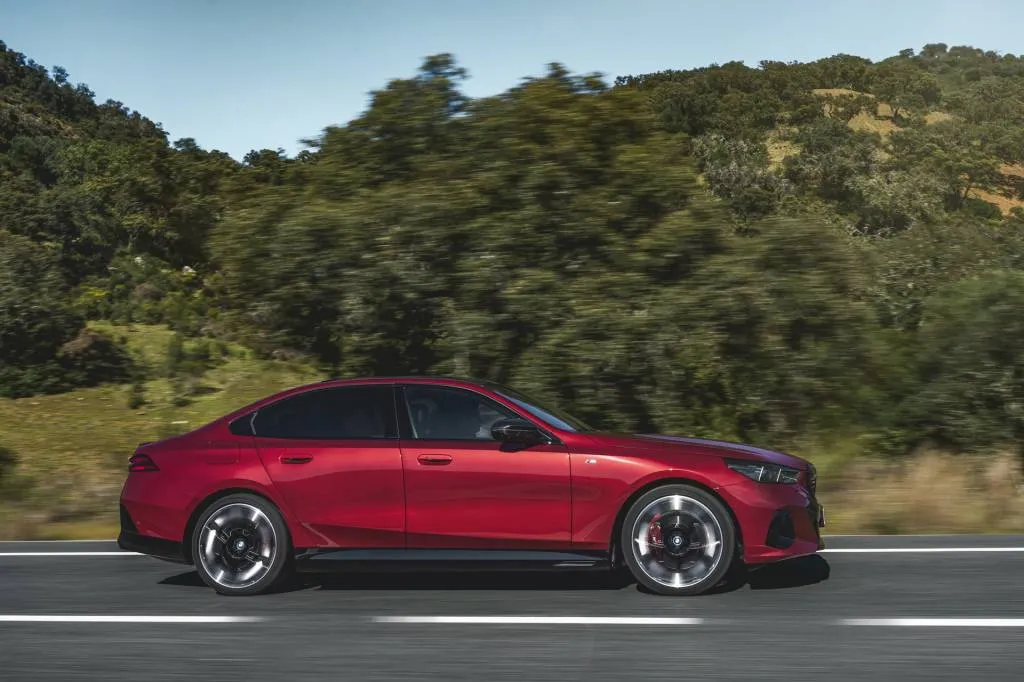
2024 BMW i5
BMW i5 range and charging
Wheel sizes vary from 19 to 21 inches, and EPA-rated range varies accordingly, as well as varying with the powertrain chosen. The longest-range version of the two i5s we drove is the RWD eDrive 40 fitted with 19-inch wheels, rated at 295 miles of range from its 82-kwh battery pack. The 20-inch wheels take that down to 278 miles, and the 21-inchers to 270 miles—a considerable hit. The more powerful AWD i5 M60 comes in at 256 miles on 19-inch wheels; the 20-inch and 21-inch wheels cut that by 8 and 16 miles, respectively.
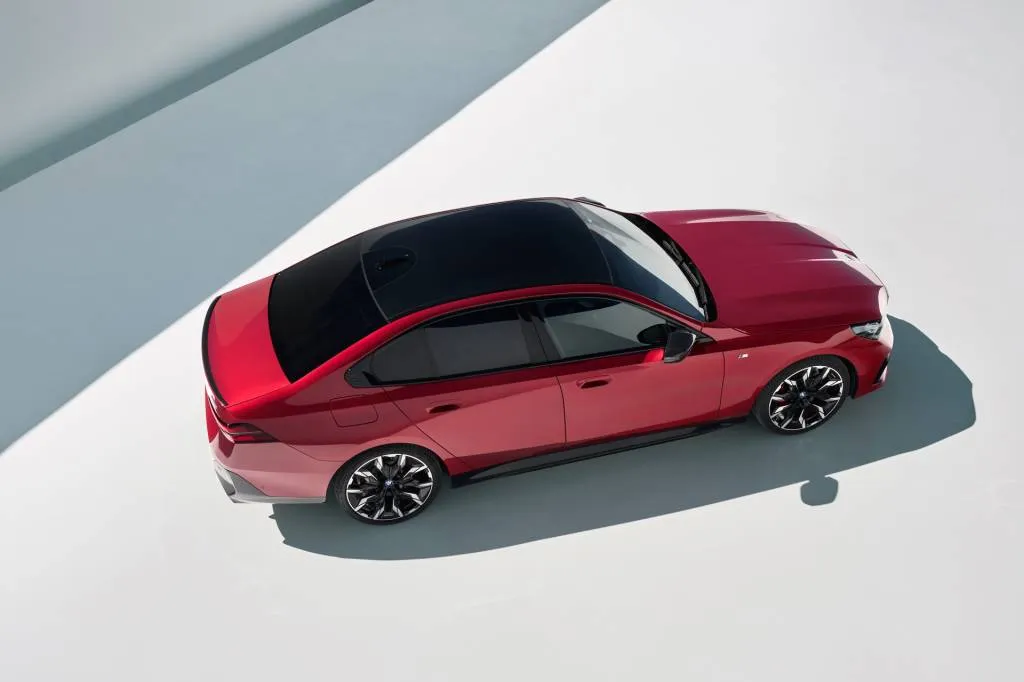
2024 BMW i5
The i5 models can charge at up to 11 kw from a Level 2 charging station that can deliver that rate. BMW provides every i5 with a mobile charging cord capable of both 120-volt and 240-volt charging, the latter using a NEMA 14-50 plug. The electric 5-Series’ DC fast-charging rate is quoted at up to 205 kw, meaning a charge from 10% to 80% of capacity in roughly 30 minutes—though the usual array of caveats, asterisks, and qualifications apply to that statistic.
The i5 is the first BMW to incorporate the Plug & Charge protocol that lets the driver walk away from a fast charger after plugging in, with validation and billing done seamlessly on the back end. The i5 also calculates both charging stops and associated thermal battery management (for the quickest charging) when the driver enters a destination into the MyBMW app. First-time BMW i5 owners receive two years of complimentary 30-minute charging sessions from the Electrify America network.
BMW provided travel and lodging expenses plus meals to enable Green Car Reports to bring you this first-person drive report.


